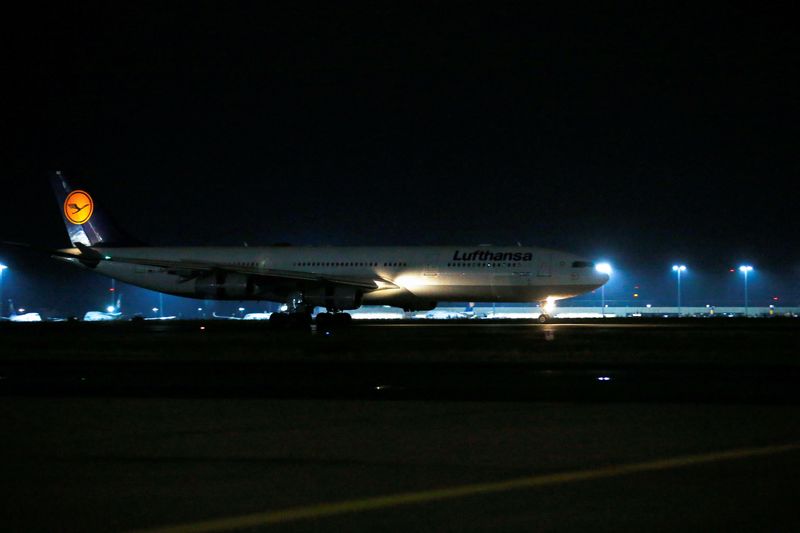By Joanna Plucinska and Lisa Barrington
LONDON/SEOUL (Reuters) -Singapore Airlines, British Airways and Lufthansa have increased their flights over Afghanistan after years of largely avoiding it now the Middle East conflict has made it seem a relatively safe option.
The carriers mostly stopped transiting Afghanistan, which lies on major routes between Asia and Europe, three years ago when the Taliban took over and air traffic control services stopped.
Those services have yet to resume, but airlines increasingly consider the skies between Iran and Israel are riskier than Afghan airspace. Many had started routing through Iran and the Middle East after Russian skies were closed to most western carriers when the Ukraine war began in 2022.
"As conflicts have evolved, the calculus of which airspace to use has changed. Airlines are seeking to mitigate risk as much as possible and they see overflying Afghanistan as the safer option given the current tensions between Iran and Israel," Ian Petchenik, a spokesperson for flight tracking organisation Flightradar24, said.
There were more than seven times the number of flights over Afghanistan in the second week of August than during the same period a year ago, according to a Reuters analysis of FlightRadar24 data.
The shift began in mid-April during reciprocal missile and drone attacks between Iran and Israel. Flight tracking data from the time shows Lufthansa, Singapore Airlines (OTC:SINGY), British Airways and others began to send a few flights a day over Afghanistan.
But the main growth has been since the killing of senior members of militant groups Hamas and Hezbollah in late July raised concerns of a major escalation.
Some pilots are concerned.
"You're depending on the analysis of your airline. Every time I fly out there, I don't like the feeling of flying over a conflict area where you don't know, actually, what is happening," said Otjan de Bruin, a commercial pilot and head of the European Cockpit Association.
"It's always safe enough, until proven otherwise."
Lufthansa Group told Reuters it decided to resume overflying Afghan airspace from early July.
Other carriers that have increased overflights since April include Turkish Airlines, Thai Airways and the Air France-KLM group, data shows.
"Based on actual security information, KLM and other airlines currently safely overfly Afghanistan only on specific routes and only at high altitudes," KLM told Reuters.
British Airways, Thai Airways, Turkish Airlines and Singapore Airlines did not respond to requests for comment.
Taiwan's EVA Air began from late July, flight tracking data shows. EVA told Reuters it chooses routes based on safety, the current international situation and flight advisories.
REGULATION'S ROLE
The route changes have been facilitated by aviation regulators easing guidance on Afghanistan.
The U.S. Federal Aviation Administration (FAA) in early July said planes could fly at a lower altitude over a sliver of north-eastern Afghanistan, the Wakhan Corridor, which is used to cross from Tajikistan to Pakistan - opening that path to more types of flights.
A year earlier, the FAA lifted its ban on overflights for the entire country, but said planes must stay above 32,000 feet (9,753.6 m) where surface-to-air weapons are considered less effective.
But few started using Afghanistan until April.
Although more traffic has been using the airspace without incident, there is no guarantee of crew or passenger safety if a plane has to land, flight safety group OPSGROUP said in July.
In the absence of air traffic control, pilots crossing Afghanistan talk to nearby planes over radio according to a protocol drawn up by U.N. aviation body ICAO and Afghanistan's Civil Aviation Authority.
European aviation safety regulator EASA said in a conflict-zone information bulletin re-issued in July that "extremist non-state actor groups remain active and might sporadically target aviation facilities in multiple ways."
The industry is haunted by the memory of Malaysian Airlines Flight MH17 from Amsterdam to Kuala Lumpur, which was shot down over eastern Ukraine in 2014, as fighting raged between pro-Russian separatists and Ukrainian forces.
COST AND LIMITED CHOICE
Airlines are under pressure to save money after the loss since 2022 of many shorter paths through Russian airspace, and as they re-build from the pandemic.
There are few international rules that dictate which areas of airspace are safe and airline safety decisions are left largely to the discretion of individual carriers.

If an airline cannot fly through Russia, Ukraine or Iran, central Afghanistan offers a more direct route into southern Asia from Europe.
"This route saved us a fair chunk of time and fuel," OPSGROUP reported from a pilot in July who flew from Amsterdam to Kuala Lumpur across central Afghanistan.
